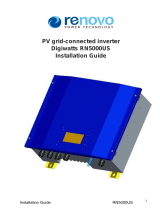
8
EN
General recommendation on installation position
• See characteristics and technical data paragraph to check the required environmental conditions (protection rating, temperature,
humidity, altitude, etc.).
• The installation location shall be easily accessible.
• Installation of the unit in a location exposed to direct sunlight NOT acceptable. (Add awning in case of direct sunlight installation).
• Final installation of the device must not compromise access to any disconnection devices that may be located externally.
• Do not install in small closed rooms where air cannot circulate freely.
• Always ensure that the flow of air around the inverter is not blocked so as to prevent overheating.
• Do not install in locations where flammable substances or gases may be present.
• Do not install on wooden walls or other flammable supports.
• Install on a wall or strong structure suitable to bear the weight.
• Do not install in rooms where people live or where the prolonged presence of people or animals is expected, because of the high noise
that the inverter produces during operation. The level of the sound emission is heavily influenced by where the appliance is installed
(for example: the type of surface around the inverter, the general properties of the room, etc.) and the quality of the electricity supply.
• All installations over 6500’ (2,000 meters) must be assessed by ABB Technical Sales to determine the proper datasheet derating.
Tilting admittance
•
The installation can be carried out with a maximum inclina-
tion as indicated in the figures beside.
NO
OK
30° MAX
±1° max
PVS-175
PVS-175
PVS-175
Vertical Tilting Side Tilting
Distances
• Hardware and software maintenance on device entails removing the front cover. Check that the
correct installation safety distances are observed in order to allow routine check and mainte-
nance operations.
• Provide sufficient working space in front of the inverter that allows to open the front cover (07)
and to make connections on the wiring box.
• Install at a height which takes into consideration the weight of the appliance and in a position
which is suitable for servicing, unless suitable means are provided to carry out the operation.
• If possible, install at eye-level so that the status LEDS (08) can be seen easily.
50cm
*100cm
(*): minimum free
space to operate
with the inverter
• Respect the minimum distances from objects around the inverter that could prevent the inverter installation and restrict or block
the air flow.
A
C
B
C
PVS-175
Available components for wiring box Quantity
Connector for connection of
the configurable relay, aux re-
lay and RS485 (pre-installed on
communication board (28))
4
Connector for connecting the
Remote ON/OFF signal (pre-
installed on communication
board (28))
3
Two-hole gasket for M25 sig-
nal cable glands (13) and cap
4 + 4
Available components for wiring box Quantity
Key tool for front cover quarter
cam-lock (05)
1
In addition to what is explained in this guide, the safety and installation information provided in the installation manual must be read and followe
The technical documentation and the interface and management software for the product are available at the website.
XXXXXXXXXXXXXXXXXXX
XXXXXXXXXXXXXXXXXXX
ABB solar inverters
Technical documentation -
Available components for bracket Quantity
M8 screws with washers for
mechanically securing the half-
brackets
2
M6 screws for mechanically se-
curing the wiring box to the
bracket
2
—
List of supplied components
—
Choice of installation location
(Continue to next page)




















